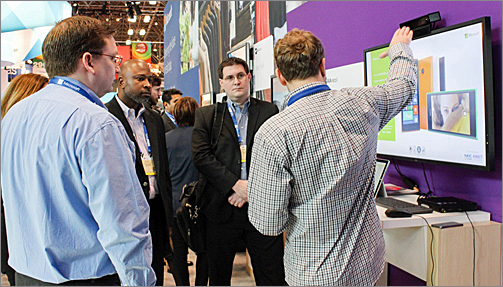Retail signage gets smart
The following blog was guest-authored by Justin Miller, an account manager for digital media and biometrics at NEC, a global provider of IT services and products.
When was the last time that you went into a retail store and—without talking with a salesperson—got more information about a product or service than you could have gleaned online? That sort of memorable customer experience is exactly what the latest generation of digital retail signage can provide, and the latest Kinect sensor is one reason why.
Retailers have been intrigued with digital signage since the price of large displays started falling in the late 2000s. The shift to digital meant that stores and restaurants could change their pricing, menus, or other details in real time, without needing to replace physical placards. Today, there are essentially three types of customer-facing digital signage: passive, interactive, and intelligent signs.

Microsoft's Kinect-enabled intelligent signage system drew crowds at the 2015 National Retail
Federation trade show.
Passive signage is the kind you’re likely to encounter at a fast-food restaurant. Typically displayed on one or more screens, the message either doesn’t change at all or changes only at set intervals, as when a digital menu switches from breakfast to lunch at 11:00 A.M. Passive signage can be hosted on a local machine or over the Internet, and it’s generally more cost effective than running print jobs every time a business wants to change its offerings or prices. Although it’s very practical, it lacks the interactive element that really draws people in.
Interactive signage provides a level of user interaction by being “triggered” by an event. Think of iBeacon, the indoor positioning system that can send a coupon to a smartphone when a customer enters his favorite clothing store or can display information about a painting when a museum patron holds her phone next to it. In other cases, sensors trigger the interactive signage, as when, for example, lifting a bottle of Bordeaux from the shelf at the wine store trips a light sensor, which prompts the display of a map of the Bordeaux region along with information about the wine. Such signage is indeed interactive, but it offers only one level of engagement between the individual and the display, and the engagement itself is not always intuitive.
Intelligent signage, by contrast, creates intuitive, compelling in-store experiences. It encourages customers to interact with and order products on-screen. It also feeds interaction data back to the retailer or business owner. Intelligent signage represents the cutting edge of technology in retail and digital advertising.
Among the most advanced intelligent signage systems is Microsoft’s Kinect-enabled solution. The Kinect sensor detects a customer’s proximity to the display and perceives his or her interaction with products on a shelf. Different distances and interactions trigger different layers of contextual signage, including static or video advertisement screens, product pricing, product technical specs, user reviews from the web, and more. Moreover, the system incorporates NEC’s facial recognition and demographic software, which enables it to determine anonymous demographic information, including the shopper’s gender and approximate age. The system also records the amount of time customers spend looking at various products, data that helps advertisers and business owners understand their audience and the efficacy of their signage.

Microsoft's intelligent signage solution includes data on the age and gender of shoppers who
show interest in a product.
Intelligent signage systems use advanced yet inexpensive hardware including the Kinect sensor and lightweight PCs, such as those embedded in NEC commercial displays. Moreover, they can be combined with sensors in the ceiling (so-called in-store heat mapping) to give the business owner a broad understanding of how people traverse a particular store. In addition, the intelligent signage data can be linked to point-of-sale data, providing the owner with demographic information on the appeal of various products. This is essentially web analytics for the tangible world, and it’s going to change the way that you experience retail.

The intelligent signage system also provides analytics on store traffic, helping retailers
understand how traffic patterns affect sales.
What’s next? With the digital signage market projected to grow a staggering 65% in 2015 alone, it’s more than likely that intelligent signage and audience measurement systems will be arriving soon at a business near you. It all sounds a bit like something out of the movie, Minority Report, but consumers need not worry about losing their anonymity. Businesses can only collect anonymous data about customer demographics unless shoppers opt-in to a customer loyalty program. Overall, intelligent signage will lead not only to greater efficiencies in the retail sector, but also far more interesting in-store experiences for shoppers.
Justin Miller, Account Manager for Digital Media and Biometrics, NEC
Key links